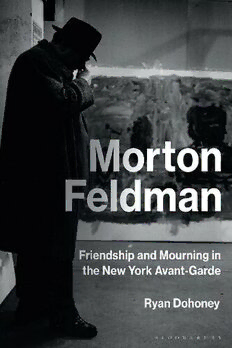
Morton Feldman: Friendship and Mourning in the New York Avant-Garde PDF
Preview Morton Feldman: Friendship and Mourning in the New York Avant-Garde
Morton Feldman ii Morton Feldman Friendship and Mourning in the New York Avant-Garde Ryan Dohoney BLOOMSBURY ACADEMIC Bloomsbury Publishing Inc 1385 Broadway, New York, NY 10018, USA 50 Bedford Square, London, WC1B 3DP, UK 29 Earlsfort Terrace, Dublin 2, Ireland BLOOMSBURY, BLOOMSBURY ACADEMIC and the Diana logo are trademarks of Bloomsbury Publishing Plc First published in the United States of America 2022 Copyright © Ryan Dohoney, 2022 For legal purposes the Acknowledgments on pp. 195–7 constitute an extension of this copyright page. Cover design: Louise Dugdale Cover image © Renate Ponsold, “Morton Feldman in Philip Guston’s Studio” (1965) courtesy of the Paul Sacher Foundation. All rights reserved. No part of this publication may be reproduced or transmitted in any form or by any means, electronic or mechanical, including photocopying, recording, or any information storage or retrieval system, without prior permission in writing from the publishers. Bloomsbury Publishing Inc does not have any control over, or responsibility for, any third-party websites referred to or in this book. All internet addresses given in this book were correct at the time of going to press. The author and publisher regret any inconvenience caused if addresses have changed or sites have ceased to exist, but can accept no responsibility for any such changes. A catalog record for this book is available from the Library of Congress. ISBN: HB: 978-1-5013-4546-3 PB: 978-1-5013-4545-6 ePDF: 978-1-5013-4548-7 eBook: 978-1-5013-4547-0 Typeset by Deanta Global Publishing Services, Chennai, India Printed and bound in the United States of America To find out more about our authors and books visit www .bloomsbury .com and sign up for our newsletters. For Sheila Hall vi Contents List of Figures viii Introduction 1 1 Spontaneity, Intimacy, and Friendship in the 1950s 17 2 “Élan vital . . . and how to fake it” 53 Intermission: The Necessary Other 93 3 The Elegiac Science 107 4 “We broke up because of style” 143 Conclusion: Friendship’s Silence 185 Acknowledgments 195 Bibliography 198 Index 209 Figures 0.1 Howard Kanovitz, The New Yorkers II (1966) 2 1.1 Projection 2 (page 1) by Morton Feldman 25 1.2 Intersection (page 1) by Morton Feldman 29 1.3 Marginal Intersection (page 1) by Morton Feldman 33 1.4 Philip Guston, Head–Double View, 1958 41 2.1 Morton Feldman, Intermission 6, first version 61 2.2 Merle Marsicano 62 2.3 Morton Feldman, Figure of Memory (reconstruction by Edwin Hymovitz) 64 2.4 Works of Calder, directed by Herbert Matter, 1950 70 2.5 Jackson Pollock 51, directed by Hans Namuth, 1951 76 2.6 Jackson Pollock 51, directed by Hans Namuth, 1951 78 2.7 Sculpture by Lipton, directed by Nathan Boxer, 1954 82 I.1 William Lovelace. L to R: Nicholas Zumbro, Morton Feldman, Edgard Varèse, Frederic Rzweski, Charlotte Moorman 94 I.2 Projection 1 (page 1) by Morton Feldman with Charlotte Moorman’s realization 97 3.1 Morton Feldman, “Give My Regards to Eighth Street,” working copy of Three Clarinets, Cello, and Piano 115 3.2 Morton Feldman, “In Memory of My Feelings,” working copy of For Frank O’Hara 117 3.3 Paula Court. Joan La Barbara 126 4.1 Renate Ponsold. Morton Feldman and Philip Guston 144 4.2 Philip Guston, Last Piece, 1958 149 4.3 Philip Guston, Attar, 1953 150 4.4 Philip Guston, Friend—To M.F., 1978 163 4.5 Philip Guston, The Coat II, 1977 165 4.6 Philip Guston, Back View, 1977 166 Introduction In Howard Kanovitz’s The New Yorkers II (1965, Figure 0.1), Morton Feldman sits in the painter’s Second Avenue studio. He is shown on the far left in profile, eyes downcast, a cigarette in his hand. Others in the painting seem similarly distracted. Larry Rivers, back and to Feldman’s left, also gazes downward. Sam Hunter, in front of Rivers, stares at the back wall of the studio. Next to the window, Kanovitz himself prepares to take a drag while looking past Alex Katz, who stands in the foreground with his back to us. An unidentified man in the foreground also gazes down. Positioned between Kanovitz and Katz, B. H. Friedman looks to the far left, past Feldman. Our focus is drawn to the center of the canvas, where poet and critic Frank O’Hara, with louche countenance and limp wrist, exudes camp glamour. Along with being a signature photorealist work of the 1960s, The New Yorkers II is a curious social text. It portrays a group of close friends, all extensively involved in the midcentury avant-garde and each other’s work. Frank O’Hara wrote poems and essays about Feldman and Rivers.1 His great long poem “Second Avenue” was written in Kanovitz’s studio that the painting depicts. Friedman edited Feldman’s collected writings.2 Kanovitz’s photo portrait of Feldman appeared on the cover for the composer’s 1968 LP, The Early Years (itself a reissue of a record from 1959 with liner notes by O’Hara).3 Katz and Feldman served together on the faculty of Mercedes Matter’s Studio School.4 Rivers and Kanovitz played jazz together in the Village and Feldman arranged tunes for them.5 Hunter wrote the foundational Modern American Painting and Sculpture, which positioned the New York avant-garde within the broader arc of modernism and which Feldman taught in his classes at the University of Buffalo.6 Yet, despite all this intimacy, these men can’t seem to face one another. O’Hara is radiant, of course, but no one can fix eyes on him. If this is an example of what Lytle Shaw would call coterie art, what do these deferrals of vision say about this community of friends? Connection and communication
